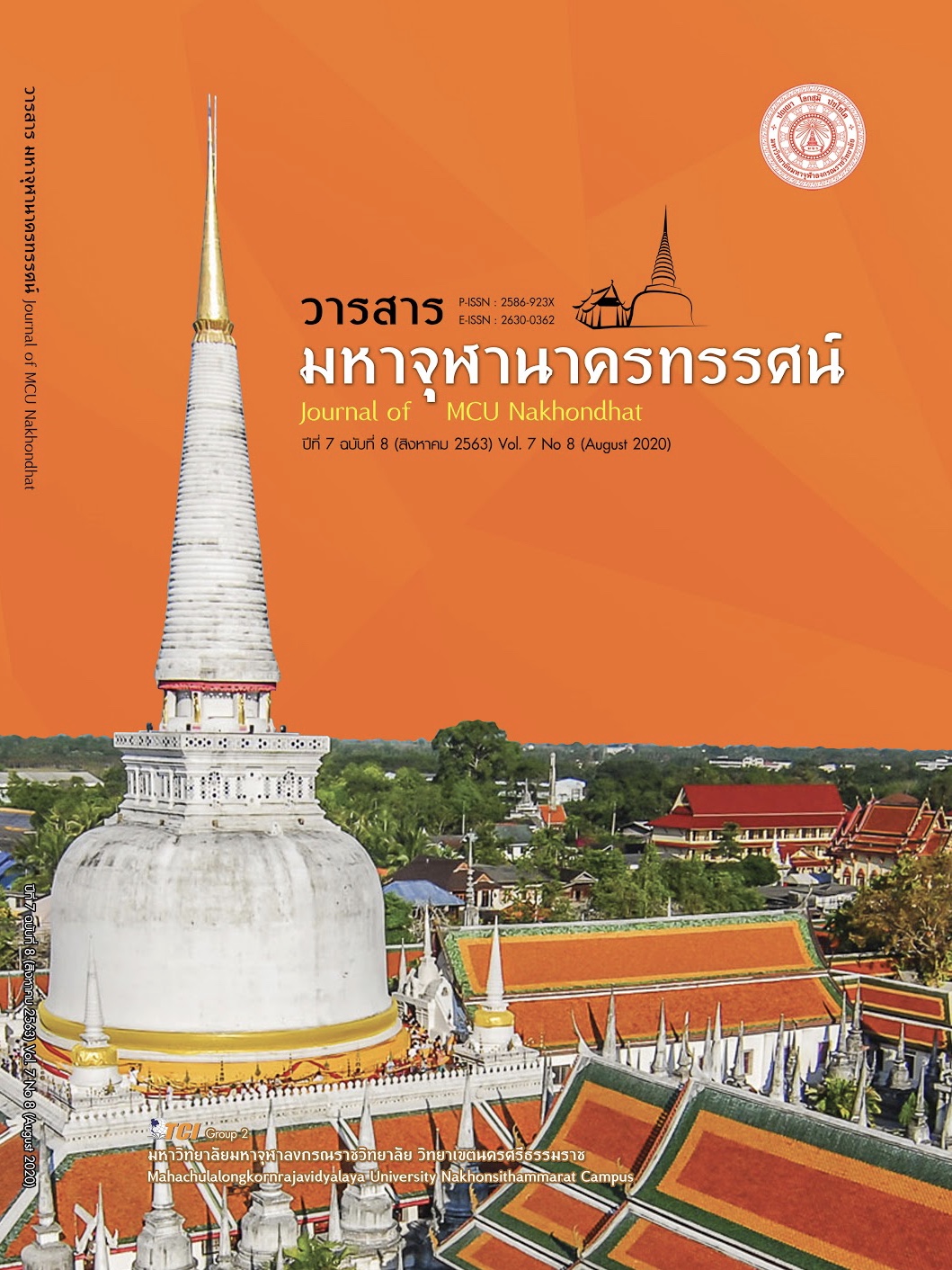DEVELOPMENT OF MATHEMATICS LEARNING ACHIEVEMENT AND MATHEMATICAL CONNECTION ABILITY OF MATAYOMSUKSA 5 STUDENTS BY USING PROBLEM – BASED LEARNING MANAGEMENT
Main Article Content
Abstract
This research is an action research. The objective is to develop of Learning Achievement and Mathematical Connection Ability of Mathayomsuksa 5 students in Interest and the value of money by using Problem – Based Learning Management to pass the criteria of 50 percent of the full score. The target group was 35 students of mathayomsuksa 5 students in the academic year 2019 from Borabuwittayakhan School, Borabu, Mahasarakram. They were selected by using Purposive Sampling for 1 classroom. The research instruments are lesson plans using problem – based learning on the topic of Interest and the value of money, Mathematical Connection Ability test, learning achievement test, the observation form, the interview form The data was analyzed by using mean, percentage and standard deviation. In the research, it was found that: The Mathematical Connection Ability score of mathayomsuksa 5 students by using Problem – Based Learning Management is as follows: In the first, second, and third spirals, the averages are 35.00 percent, 46.07 percent, and 58.19 percent, respectively. In the third spiral, each of the students scores is higher than 50 percent of the full score. And learning achievement score is as follows: In the first, second, and third spirals, the averages are 29.43 percent, 45.43 percent, and 58.29 percent, respectively. In the third spiral, each of the students scores is higher than 50 percent of the full score. And, the Mathematical Connection Ability and learning achievement score is increased in each spiral. It showed that learning by using problem – based learning can develop the Mathematical Connection Ability and learning achievement of students.
Article Details
References
กัญญา โพธิวัฒน์. (2542). พฤติกรรมการสอนคณิตศาสตร์ ระดับประถมศึกษา. สุรินทร์: สถาบันราชภัฏสุรินทร์.
กุลนันท์ กลิ่นสุวรรณ. (2558). ผลสัมฤทธิ์ทางการเรียนวิชาคณิตศาสตร์ต่ำ. เรียกใช้เมื่อ 10 มกราคม 2563 จาก http: //gullanun302.blogspot.com/2015/11/cognitive domain – wilson.html
ชานนท์ จันทรา. (2554). การประเมินความสามารถทางคณิตศาสตร์ของผู้เรียน. ประมวลชุดวิชาการจัดประสบการณ์การเรียนรู้คณิตศาสตร์ หน่วยที่ 8 – 15. นนทบุรี: มหาวิทยาลัยสุโขทัยธรรมาธิราช.
ทวีศักดิ์ ภวนานันท์. (2545). การพัฒนาบทเรียนคอมพิวเตอร์ช่วยสอนที่นําเสนอด้วยเทคนิคการเขียนแผนที่ความคิด เรื่อง การเพาะเลี้ยงปลากัด. ใน วิทยานิพนธ์ศึกษาศาสตรมหาบัณฑิต สาขาวิชาเทคโนโลยีการศึกษา. มหาวิทยาลัยเกษตรศาสตร์.
นุชนารถ ทองกระจ่าง. (2556). การพัฒนาทักษะการเชื่อมโยงทางคณิตศาสตร์ เรื่องความน่าจะเป็นด้วยกิจกรรมการเรียนรู้แบบใช้ปัญหาเป็นฐานสำหรับนักเรียนชั้นมัธยมศึกษาปีที่ 3. ใน วิทยานิพนธ์ศึกษาศาสตรมหาบัณฑิต สาขาวิชาหลักสูตรและการสอน. มหาวิทยาลัยบูรพา.
ปราณี ตปนียวรวงศ์. (2557). การสอนเพื่อพัฒนาทักษะการเรียนรู้ในศตวรรษที่ 21. เรียกใช้เมื่อ 12 มกราคม 2563 จาก apr.nsru.ac.th/Act_learn/myfile/18032015144722 _article.doc
พันธ์ ทองชุมนุม. (2547). การสอนวิทยาศาสตร์ระดับประถมศึกษา. กรุงเทพมหานคร: โอเดียนสโตร์.
มัณฑรา ธรรมบุศย์. (2545). การพัฒนาคุณภาพการเรียนรู้ โดยใช้ PBL (Problem – Based. Learning). วารสารวิชาการ, 5(2), 11–17.
วาสนา กิ่มเทิ้ง. (2553). ผลการจัดกิจกรรมการเรียนรู้โดยใช้ปัญหาเป็นฐาน (Problem – Based Learning) ที่มีต่อทักษะการแก้ปัญหา ทักษะการเชื่อมโยงทางคณิตศาสตร์และความใฝ่รู้ใฝ่เรียนของนักเรียนชั้นมัธยมศึกษาปีที่ 3. ใน วิทยานิพนธ์ศึกษาศาสตรมหาบัณฑิต สาขาวิชาการมัธยมศึกษา. มหาวิทยาลัยศรีนครินทรวิโรฒ.
สุวิมล ว่องวาณิช. (2543). การวิจัยปฏิบัติการในชั้นเรียน. กรุงเทพมหานคร: สำนักพิมพ์จุฬาลงกรณ์มหาวิทยาลัย.
Arends, R. (1994). Learning to teach. (3rd ed.). New York: McGraw Hill.
Boaler, J. (1998). Open and Closed Mathematics: Student Experiences and Understandings. Journal for Research in Mathematics Education, 29(1), 41–62.
Kennedy, L. M. & Tipps, S. (1994). Guiding Children’s Learning of Mathematics. (7th ed.). Belmont, California: Wadsworth.
National Council of Teachers of Mathematics (NCTM). (1989). Curriculum and Evaluation Standards for School Mathematics. Reston, VA: Author.
Thomas, C. D. & Santiago, C. (2002). Building Mathematically Powerful students through Connections. National Council of Teachers of Mathematics. Mathematics Teaching in the Middle School, 7(9), 484–488.


